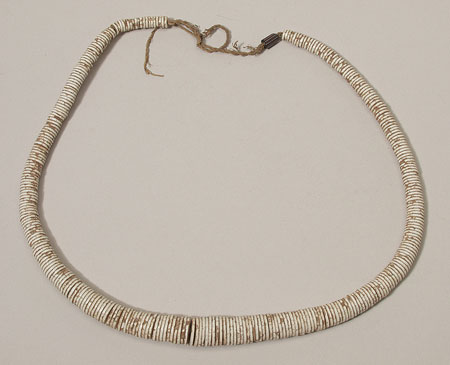Accession Number:
1917.21.3
Country:
Sudan
Region:
South of Kodok Upper Nile ?Bahr el Abiad
Date Made:
By 1917
Materials:
Ostrich Eggshell Bird , Glass , Plant Fibre
Process:
Chip Carved , Perforated , Twisted , Drawn , Strung
Dimensions:
L = 387 (as strung), diam ostrich eggshell beads min = 8.4 mm, max = 18.8 mm, glass bead L = 12, diam = 7.2 mm [RTS 11/8/2004].
Weight:
201.1 g
Other Owners:
Herbert Joseph Weld-Blundell
Field Collector:
Herbert Joseph Weld-Blundell
PRM Source:
Herbert Joseph Weld-Blundell
Acquired:
Donated June 1917
Collected Date:
By 1917
Description:
Necklet, consisting of a length of cord made from two strands of yellowish brown plant fibre (Pantone 7508C) twisted together then knotted loosely at the top.
This fibre seems stiff and may be composed of grass or bark strips.
The cord has been strung with a series of 352 white ostrich eggshell beads, each chipped into a circular disc with flat upper and lower surfaces, a medium sized to small thread hole through the centre, and with polished outer edges.
These gradually increase in size, from a diameter of 8.4 mm at the ends of the necklace, to 18.8 mm at its centre.
In addition, there is a single opaque glass bead strung at one end.
This has a cylindrical body with black matrix (Pantone black 6C) and alternating thin white and thick red stripes (Pantone 201C) along the outside face of the body; it was probably manufactured by being drawn and then cut to the appropriate length; each end has been cut at an angle.
The hole would be a feature of the cane from which this was made, rather than the result of individual perforation.
The necklet is nearly complete, but a few ostrich eggshell beads have been chipped and are missing parts of their outer edges and the cord is beginning to fray in places.
It has a weight of 201.1 grams, and a length of 387 mm as strung, with the cord having a diameter of 2.7 mm and the glass bead being 12 mm long and 7.2 mm in diameter.
Collected by Herbert Joseph Weld-Blundell, who said that it was made by ‘tribes to the south of Fashoda, on the banks of the White Nile’. Fashoda is now known by its modern name of Kodok.
Carey suggests that ostrich eggshell beads were made by chipping the material to the correct size then boring a hole through it, after soaking the eggshell in water to prevent the material splitting. Several partially worked beads could then be strung together and the edges ground to finish them off. It was possible to make around one hundred beads of this kind per day (M. Carey, Beads and Beadwork of East and South Africa, 1986, p. 9).
Rachael Sparks 30/9/2005.
Collected by Herbert Joseph Weld-Blundell, who said that it was made by ‘tribes to the south of Fashoda, on the banks of the White Nile’. Fashoda is now known by its modern name of Kodok.
Carey suggests that ostrich eggshell beads were made by chipping the material to the correct size then boring a hole through it, after soaking the eggshell in water to prevent the material splitting. Several partially worked beads could then be strung together and the edges ground to finish them off. It was possible to make around one hundred beads of this kind per day (M. Carey, Beads and Beadwork of East and South Africa, 1986, p. 9).
Rachael Sparks 30/9/2005.
Primary Documentation:
Accession Book Entry
[VI, p.
52] - 1917 [pencil insert] 21 [end insert]
H.J.
WELD-BLUNDELL
, Esq.
B.Litt., Queens Coll[ege], Oxford.
[...] Dec[ember].
[pencil insert] 3 [end insert] - Necklet of disks of ostrich egg-shell, made by tribes to the S[outh].
of Fashoda, on the banks of the White Nile.
Card Catalogue Entry - There is no further information on the catalogue card [RTS 30/1/2004].
Pitt Rivers Museum label - Necklet of ostrich egg-shell disks, made by tribes to the S. of FASHODA, on banks of the WHITE NILE. Pres. by H.J. Weld Blundell, 1917 [rectangular metal-edged tag, tied to object; RTS 11/8/2004].
Card Catalogue Entry - There is no further information on the catalogue card [RTS 30/1/2004].
Pitt Rivers Museum label - Necklet of ostrich egg-shell disks, made by tribes to the S. of FASHODA, on banks of the WHITE NILE. Pres. by H.J. Weld Blundell, 1917 [rectangular metal-edged tag, tied to object; RTS 11/8/2004].



